Rapid Reaction: April New Home Sales
April new home sales fell 1.5 percent from March to 662,000 units (SAAR), according to the U.S. Census Bureau, and were up 11.6 percent from a year ago. Data from the first three months of the year was downwardly revised by a combined 41,000 units.
- April new home sales fell 1.5 percent from March to 662,000 units (SAAR), according to the U.S. Census Bureau, and were up 11.6 percent from a year ago. Data from the first three months of the year was downwardly revised by a combined 41,000 units.
- There were 300,000 new homes for sale at the end of April, up 0.7 percent from March and 12.4 percent from a year ago.
- The median, non-seasonally adjusted price of new homes sold in April was $312,400, up 0.4 percent from a year ago.
April’s slight monthly decline in new home sales was actually smaller than expected and doesn’t represent much of a deviation from the general strength we’ve seen in the new home market to start 2018. Sales remain up strongly over the past year, and a fourth monthly increase in a row to start the year would have been very rare: In the 659 months that have passed between May 1963 and today, monthly new home sales have risen in four consecutive months just 4 percent of the time. So despite the blip, the trends we’ve been observing for several months still very much hold. A generally strong economy and favorable demographics – driven by the huge millennial generation aging into their prime home buying years – coupled with exceptionally tight inventory are helping drive home buyers to builders in increasingly large numbers. That’s good for builders’ bottom lines – because the rising costs of land, lumber and especially labor are crunching those same builders’ top lines. Today, the average U.S. residential construction wage is 13.7 percent higher than the average private-sector wage – as clear a signal as any of the intense demand for skilled manual labor not just in residential construction, but in the energy and infrastructure sectors too. In order to maintain their margins, builders have little choice but to pass these costs on to buyers, reflected in the high – and rising – price of new homes. Thus far in 2018, consumers have largely been willing and able to pay these prices to secure a new home. Whether or not they will continue to is an open question.
